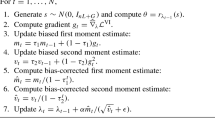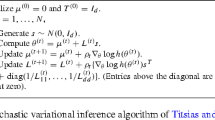Abstract
This paper presents a tutorial introduction to the use of variational methods for inference and learning in graphical models (Bayesian networks and Markov random fields). We present a number of examples of graphical models, including the QMR-DT database, the sigmoid belief network, the Boltzmann machine, and several variants of hidden Markov models, in which it is infeasible to run exact inference algorithms. We then introduce variational methods, which exploit laws of large numbers to transform the original graphical model into a simplified graphical model in which inference is efficient. Inference in the simpified model provides bounds on probabilities of interest in the original model. We describe a general framework for generating variational transformations based on convex duality. Finally we return to the examples and demonstrate how variational algorithms can be formulated in each case.
Article PDF
Similar content being viewed by others
Explore related subjects
Discover the latest articles, news and stories from top researchers in related subjects.Avoid common mistakes on your manuscript.
References
Bathe, K. J. (1996). Finite element procedures. Englewood Cliffs, NJ: Prentice-Hall.
Baum, L. E., Petrie, T., Soules, G., & Weiss, N. (1970). A maximization technique occurring in the statistical analysis of probabilistic functions of Markov chains. The Annals of Mathematical Statistics, 41, 164–171.
Bishop, C. M., Lawrence, N., Jaakkola, T. S., & Jordan, M. I. (1998). Approximating posterior distributions in belief networks using mixtures. In M. Jordan, M. Kearns, & S. Solla (Eds.), Advances in neural information processing systems 10, Cambridge MA: MIT Press.
Cover, T., & Thomas, J. (1991). Elements of information theory. New York: John Wiley.
Dagum, P., & Luby, M. (1993). Approximating probabilistic inference in Bayesian belief networks is NP-hard. Artificial Intelligence, 60, 141–153.
Dayan, P., Hinton, G. E., Neal, R., & Zemel, R. S. (1995). The Helmholtz Machine. Neural Computation, 7, 889–904.
Dean, T., & Kanazawa, K. (1989). A model for reasoning about causality and persistence. Computational Intelligence, 5, 142–150.
Dechter, R. (1999). Bucket elimination: A unifying framework for probabilistic inference. In M. I. Jordan (Ed.), Learning in graphical models. Cambridge, MA: MIT Press.
Dempster, A. P., Laird, N. M., & Rubin, D. B. (1977). Maximum-likelihood from incomplete data via the EM algorithm. Journal of the Royal Statistical Society, B39, 1–38.
Draper, D. L., & Hanks, S. (1994). Localized partial evaluation of belief networks. Uncertainty and Artificial Intelligence: Proceedings of the Tenth Conference. San Mateo, CA: Morgan Kaufmann.
Frey, B., Hinton, G. E., & Dayan, P. (1996). Does the wake-sleep algorithm learn good density estimators? In D. S. Touretzky, M. C. Mozer, & M. E. Hasselmo (Eds.), Advances in neural information processing systems 8. Cambridge, MA: MIT Press.
Fung, R. & Favero, B. D. (1994). Backward simulation in Bayesian networks. Uncertainty and Artificial Intelligence: Proceedings of the Tenth Conference. San Mateo, CA: Morgan Kaufmann.
Galland, C. (1993). The limitations of deterministic Boltzmann machine learning. Network, 4, 355–379.
Ghahramani, Z., & Hinton, G. E. (1996). Switching state-space models. (Technical Report CRG-TR–96–3). Toronto: Department of Computer Science, University of Toronto.
Ghahramani, Z., & Jordan, M. I. (1997). Factorial Hidden Markov models. Machine Learning, 29, 245–273.
Gilks, W., Thomas, A., & Spiegelhalter, D. (1994). A language and a program for complex Bayesian modelling. The Statistician, 43, 169–178.
Heckerman, D. (1999). A tutorial on learning with Bayesian networks. In M. I. Jordan (Ed.), Learning in graphical models. Cambridge, MA: MIT Press.
Henrion, M. (1991). Search-based methods to bound diagnostic probabilities in very large belief nets. Uncertainty and Artificial Intelligence: Proceedings of the Seventh Conference. San Mateo, CA: Morgan Kaufmann.
Hinton, G. E., & Sejnowski, T. (1986). Learning and relearning in Boltzmann machines. In D. E. Rumelhart & J. L. McClelland (Eds.), Parallel distributed processing (Vol. 1). Cambridge, MA: MIT Press.
Hinton, G. E., & van Camp, D. (1993). Keeping neural networks simple by minimizing the description length of the weights. Proceedings of the 6th Annual Workshop on Computational Learning Theory. New York, NY: ACM Press.
Hinton, G. E., Dayan, P., Frey, B., & Neal, R. M. (1995). The wake-sleep algorithm for unsupervised neural networks. Science, 268, 1158–1161.
Hinton, G. E., Sallans, B., & Ghahramani, Z. (1999). A hierarchical community of experts. In M. I. Jordan (Ed.), Learning in graphical models. Cambridge, MA: MIT Press.
Horvitz, E. J., Suermondt, H. J., & Cooper, G. F. (1989). Bounded conditioning: Flexible inference for decisions under scarce resources. Conference on Uncertainty in Artificial Intelligence: Proceedings of the Fifth Conference. Mountain View, CA: Association for UAI.
Jaakkola, T. S., & Jordan, M. I. (1996). Computing upper and lower bounds on likelihoods in intractable networks. Uncertainty and Artificial Intelligence: Proceedings of the Twelth Conference. San Mateo, CA: Morgan Kaufmann.
Jaakkola, T. S. (1997). Variational methods for inference and estimation in graphical models. Unpublished doctoral dissertation, Massachusetts Institute of Technology, Cambridge, MA.
Jaakkola, T. S., & Jordan, M. I. (1997a). Recursive algorithms for approximating probabilities in graphical models. In M. C. Mozer, M. I. Jordan, & T. Petsche (Eds.), Advances in neural information processing systems 9. Cambridge, MA: MIT Press.
Jaakkola, T. S., & Jordan, M. I. (1997b). Bayesian logistic regression: A variational approach. In D. Madigan & P. Smyth (Eds.), Proceedings of the 1997 Conference on Artificial Intelligence and Statistics. Ft. Lauderdale, FL.
Jaakkola, T. S., & Jordan, M. I. (1999a). Improving the mean field approximation via the use of mixture distributions. In M. I. Jordan (Ed.), Learning in graphical models. Cambridge, MA: MIT Press.
Jaakkola, T. S., & Jordan, M. I. (1999b). Variational methods and the QMR-DT database. Journal of Artificial Intelligence Research, 10, 291–322.
Jensen, C. S., Kong, A., & Kjærulff, U. (1995). Blocking-Gibbs sampling in very large probabilistic expert systems. International Journal of Human-Computer Studies, 42, 647–666.
Jensen, F. V., & Jensen, F. (1994). Optimal junction trees. Uncertainty and Artificial Intelligence: Proceedings of the Tenth Conference. San Mateo, CA: Morgan Kaufmann.
Jensen, F. V. (1996). An introduction to Bayesian networks. London: UCL Press.
Jordan, M. I. (1994). A statistical approach to decision tree modeling. In M. Warmuth (Ed.), Proceedings of the Seventh Annual ACM Conference on Computational Learning Theory. New York: ACM Press.
Jordan, M. I., Ghahramani, Z., & Saul, L. K. (1997). Hidden Markov decision trees. In M. C. Mozer, M. I. Jordan, & T. Petsche (Eds.), Advances in neural information processing systems 9. Cambridge, MA: MIT Press.
Kanazawa, K., Koller, D., & Russell, S. (1995). Stochastic simulation algorithms for dynamic probabilistic networks. Uncertainty and Artificial Intelligence: Proceedings of the Eleventh Conference. San Mateo, CA: Morgan Kaufmann.
Kjærulff, U. (1990). Triangulation of graphs—Algorithms giving small total state space. (Research Report R–90–09). Department of Mathematics and Computer Science, Aalborg University, Denmark.
Kjærulff, U. (1994). Reduction of computational complexity in Bayesian networks through removal of weak dependences. Uncertainty and Artificial Intelligence: Proceedings of the Tenth Conference. San Mateo, CA: Morgan Kaufmann.
MacKay, D. J. C. (1997). Ensemble learning for hidden Markov models. Unpublished manuscript. Cambridge: Department of Physics, University of Cambridge.
McEliece, R. J., MacKay, D. J. C., & Cheng, J.-F. (1998). Turbo decoding as an instance of Pearl's “belief propagation algorithm.” IEEE Journal on Selected Areas in Communication, 16, 140–152.
Merz, C. J., & Murphy, P. M. (1996). UCI repository of machine learning databases. Irvine, CA: Department of Information and Computer Science, University of California.
Neal, R. (1992). Connectionist learning of belief networks. Artificial Intelligence, 56, 71–113.
Neal, R. (1993). Probabilistic inference using Markov chain Monte Carlo methods. (Technical Report CRG-TR–93–1). Toronto: Department of Computer Science, University of Toronto.
Neal, R., & Hinton, G. E. (1999). A view of the EM algorithm that justifies incremental, sparse, and other variants. In M. I. Jordan (Ed.), Learning in graphical models. Cambridge, MA: MIT Press.
Parisi, G. (1988). Statistical field theory. Redwood City, CA: Addison-Wesley.
Pearl, J. (1988). Probabilistic reasoning in intelligent systems: Networks of plausible inference. San Mateo, CA: Morgan Kaufmannn.
Peterson, C., & Anderson, J. R. (1987). A mean field theory learning algorithm for neural networks. Complex Systems, 1, 995–1019.
Rockafellar, R. (1972). Convex analysis. Princeton University Press.
Rustagi, J. (1976). Variational methods in statistics. New York: Academic Press.
Sakurai, J. (1985). Modern quantum mechanics. Redwood City, CA: Addison-Wesley.
Saul, L. K., & Jordan, M. I. (1994). Learning in Boltzmann trees. Neural Computation, 6, 1173–1183.
Saul, L. K., Jaakkola, T. S., & Jordan, M. I. (1996). Mean field theory for sigmoid belief networks. Journal of Artificial Intelligence Research, 4, 61–76.
Saul, L. K., & Jordan, M. I. (1996). Exploiting tractable substructures in intractable networks. In D. S. Touretzky, M. C. Mozer, & M. E. Hasselmo (Eds.), Advances in neural information processing systems 8. Cambridge, MA: MIT Press.
Saul, L. K., & Jordan, M. I. (1999). A mean field learning algorithm for unsupervised neural networks. In M. I. Jordan (Ed.), Learning in graphical models. Cambridge, MA: MIT Press.
Seung, S. (1995). Annealed theories of learning. In J.-H. Oh, C. Kwon, S. Cho (Eds.), Neural networks: The statistical mechanics perspectives. Singapore: World Scientific.
Shachter, R. D., Andersen, S. K., & Szolovits, P. (1994). Global conditioning for probabilistic inference in belief networks. Uncertainty and Artificial Intelligence: Proceedings of the Tenth Conference. San Mateo, CA: Morgan Kaufmann.
Shenoy, P. P. (1992). Valuation-based systems for Bayesian decision analysis. Operations Research, 40, 463–484.
Shwe, M. A., & Cooper, G. F. (1991). An empirical analysis of likelihood—Weighting simulation on a large, multiply connected medical belief network. Computers and Biomedical Research, 24, 453–475.
Shwe, M. A., Middleton, B., Heckerman, D. E., Henrion, M., Horvitz, E. J., Lehmann, H. P., & Cooper, G. F. (1991). Probabilistic diagnosis using a reformulation of the INTERNIST-1/QMR knowledge base. Meth. Inform. Med., 30, 241–255.
Smyth, P., Heckerman, D., & Jordan, M. I. (1997). Probabilistic independence networks for hidden Markov probability models. Neural Computation, 9, 227–270.
Waterhouse, S., MacKay, D. J. C., & Robinson, T. (1996). Bayesian methods for mixtures of experts. In D. S. Touretzky, M. C. Mozer, & M. E. Hasselmo (Eds.), Advances in neural information processing systems 8. Cambridge, MA: MIT Press.
Williams, C. K. I., & Hinton, G. E. (1991). Mean field networks that learn to discriminate temporally distorted strings. In D. S. Touretzky, J. Elman, T. Sejnowski, & G. E. Hinton (Eds.), Proceedings of the 1990 Connectionist Models Summer School. San Mateo, CA: Morgan Kaufmann.
Author information
Authors and Affiliations
Rights and permissions
About this article
Cite this article
Jordan, M.I., Ghahramani, Z., Jaakkola, T.S. et al. An Introduction to Variational Methods for Graphical Models. Machine Learning 37, 183–233 (1999). https://doi.org/10.1023/A:1007665907178
Issue Date:
DOI: https://doi.org/10.1023/A:1007665907178




